Pergamon and the Hellenistic Kingdoms of the Ancient World: Three Centuries of Greek Art from Alexander the Great to Cleopatra

Fig. 1. A view of the first gallery of the exhibition Pergamon and the Hellenistic Kingdoms of the Ancient World, which presents the "Age of Alexander"
«The exhibition Pergamon and the Hellenistic Kingdoms of the Ancient World represents a historic collaboration between The Met and the Pergamon Museum in Berlin, whose celebrated sculptures comprise nearly one-third of the more than 260 artworks on view, many of them traveling to the United States for the first time. The Hellenistic period—the three centuries between the death of Alexander the Great of Macedon in 323 B.C. and the suicide of Cleopatra, queen of the Ptolemaic kingdom, in 30 B.C.—was a critical era in the history of Greek art that has traditionally received less attention than earlier periods. This extraordinary exhibition, more than five years in the making, examines the rich diversity of art forms that arose through the patronage of the royal courts of the Hellenistic Kingdoms, placing a special emphasis on Pergamon, capital of the Attalid dynasty that ruled over large parts of Asia Minor.»
This is the first major international loan exhibition devoted to the arts of the Hellenistic Age in the United States. A wide variety of sensational artworks—including marble, bronze, and terracotta sculptures; gold jewelry; vessels of glass and precious metals; and engraved gems and coins—have been carefully chosen to highlight the innovations and technical mastery achieved by Hellenistic artists, whose enduring legacy profoundly influenced Roman art. With over 50 lenders from twelve countries, the exhibition endeavors to present an expansive selection of original Hellenistic art from this complex epoch and features famous artworks as well as lesser known works of the highest quality, including finds from excavations in many parts of the Hellenistic world such as Germany, Greece, Italy, Turkey, and Morocco.
The exhibition addresses the transformation of Classical Greek art as a consequence of the conquests by Alexander the Great and his successors. Their military triumphs led to the expansion of Greek culture over an area ranging from the traditional Greek heartland to the Indus River valley in the East and the Strait of Gibraltar in the West. The newly established Hellenistic kingdoms—the Ptolemies (fig. 2), Seleucids, Attalids, and Antigonids—and the sovereign realm of the kings of Syracuse in Sicily provided concentrations of wealth and power that fostered an unparalleled burst of creativity in all arts, from architecture and sculpture to seal engraving and glass production. The works of art in the exhibition showcase the melding of Classical Greek with predominantly Eastern cultural traditions, illustrating the creation of new standards and conventions in taste and style that, in turn, led to new expressions of wealth and power through art.
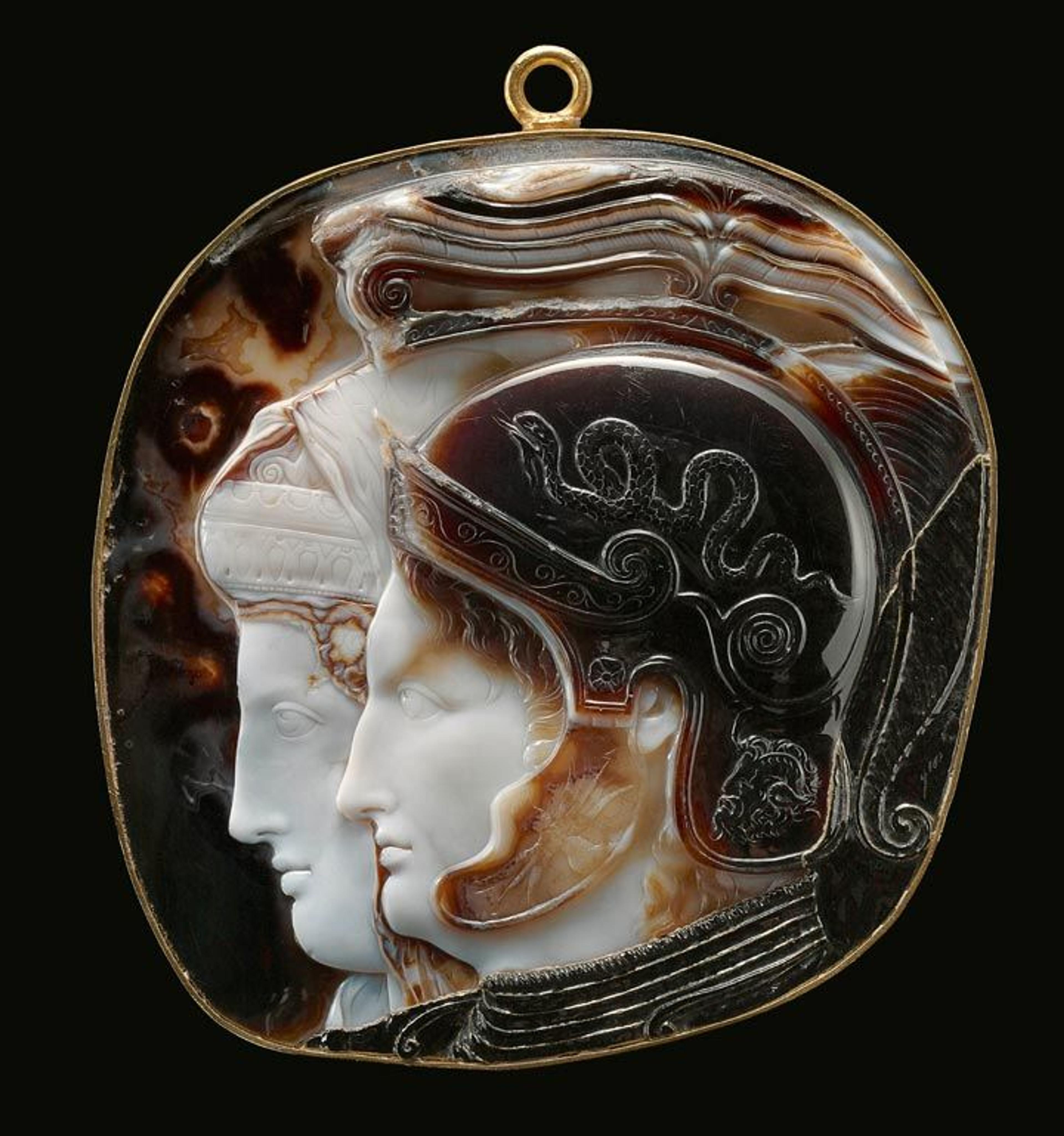
Fig. 2. Cameo with portrait heads, 278–270/69 B.C. Greek, Ptolemaic. Sardonyx; 4 1/2 x 13/16 in. (11.5 x 2 cm). Antikensammlung, Kunsthistorisches Museum, Vienna
The exhibition begins with Alexander the Great (356–323 B.C.). Alexander grew up in the royal palace at Pella in northern Greece and was given the best education that his father Philip II (r. 359–336 B.C.) could provide. Aristotle was his tutor, and Homer's Iliad was his favorite poem. Alexander came to believe that Zeus was his immortal father. In the 13 years of his reign, Alexander's conquests spread Greek civilization eastward throughout the lands of the former Persian Empire and changed the face of the ancient world forever, opening trade routes and encouraging cultural exchanges with far-reaching implications. When Alexander was on his deathbed in Babylon in 323 B.C., his generals asked to whom he would leave his kingdom, and he responded, "To the strongest." In everything, Alexander was a model for his successors who sought to link themselves to their great leader—the conqueror of the world.
Aside from his military prowess, Alexander's patronage of the arts was of particular importance. Alexander chose from among the most innovative and influential artists of his time. The famous bronze sculptor Lysippos of Sikyon was Alexander's court sculptor, who alone was permitted to create official portrait sculptures of the king. His other favored artists were the painter Apelles, the gem cutter Pyrgoteles, and the architect Deinokrates, who planned Alexandria in Egypt, a future center of the Hellenistic world. Alexander is thought to have founded some 20 cities from Egypt to India. His many personal, civic, and religious commissions reveal his taste in monuments, which tended toward ingenuity, boldness, and magnificence.
The patronage of the Hellenistic kings led to the development of new institutions that have become pillars of modern civilization. For the first time, great libraries were formed such as those at Alexandria in Egypt and at Pergamon, where it is believed the use of parchment was first invented. (In Latin, parchment was known as pergamina.) The first museums, literally "seats of the Muses," were created as centers of intellectual growth, where some of the greatest minds of the day gathered to promote learning and knowledge. The notion of art history and the practice of connoisseurship began at this time.
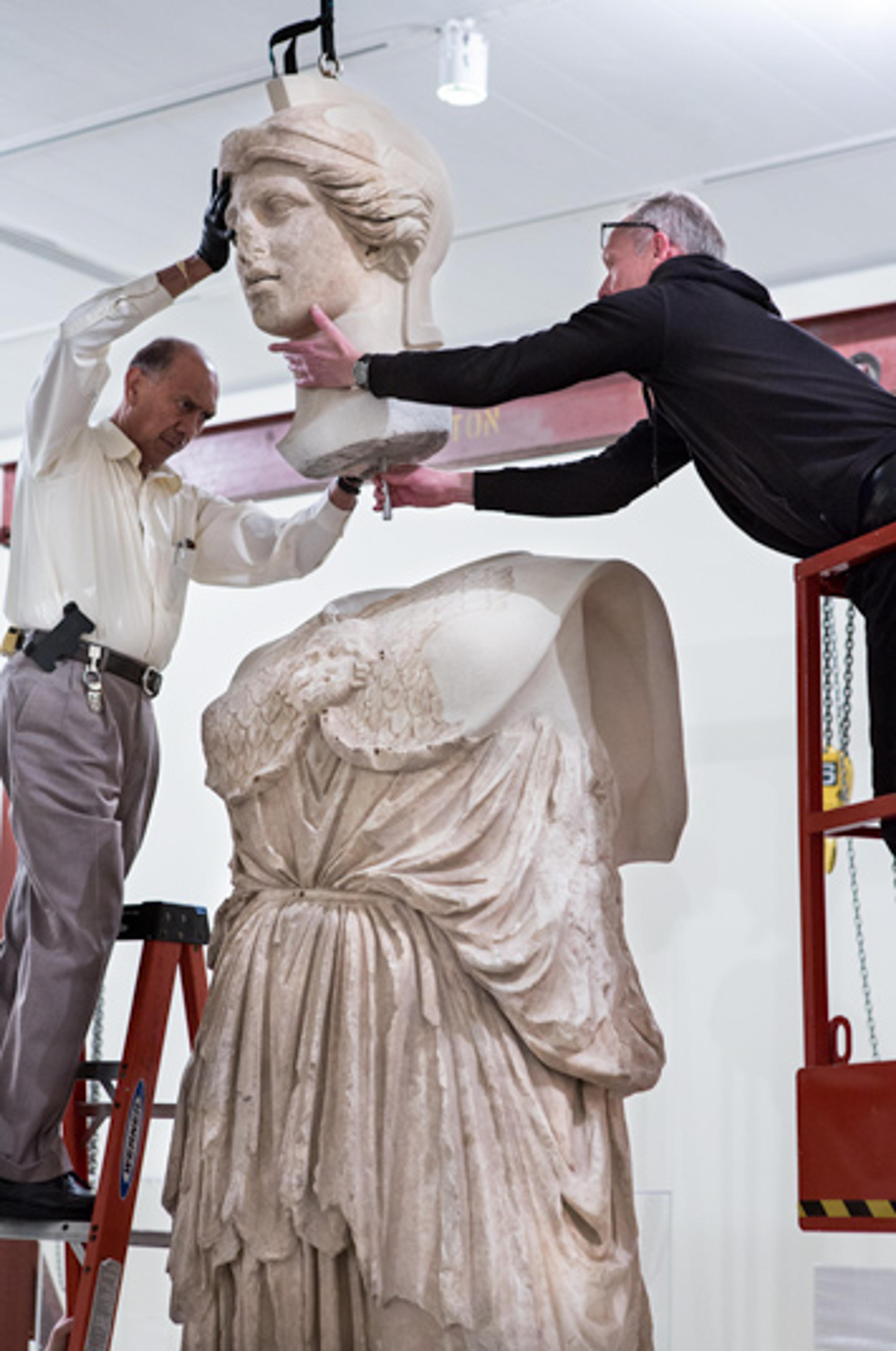
At the heart of these endeavors in Hellenistic Pergamon was the sanctuary of Athena, goddess of wisdom, who is represented by the 10-foot-tall Hellenistic marble statue of Athena Parthenos, excavated there and newly restored for the exhibition. The largest sculpture presented in the show and weighing nearly 8,000 pounds, it was no small feat to bring it to New York, a task successfully completed by a team of specialists from The Met and the Berlin State Museums (fig. 3). This statue is a large-scale free copy of the famous fifth-century B.C. chryselephantine cult statue by Pheidias from the Parthenon on the Athenian Acropolis, demonstrating the close ties the Attalids had to Athens and their great respect for knowledge and history.
Left: Fig. 3. Crayton Sohan and Wolfgang Massmann installing the head of the colossal Athena Parthenos
The astounding wealth of the Hellenistic kingdoms is most evident in the opulent luxury items that were produced for royalty and other elite members of society by artisans skilled in glass making, precious metalworking, and gem carving. The practice of cameo engraving was invented in the Hellenistic period and is represented in the exhibition by one of the largest and most spectacular examples known, the "Vienna Cameo" (see fig. 2), which depicts a king and queen from Ptolemaic Egypt richly attired and imbued with divine symbolism. Images of the Attalid royal family and the aristocracy of other kingdoms give a face to the people who lived in palaces, where they hosted elegant banquets with sophisticated entertainment.
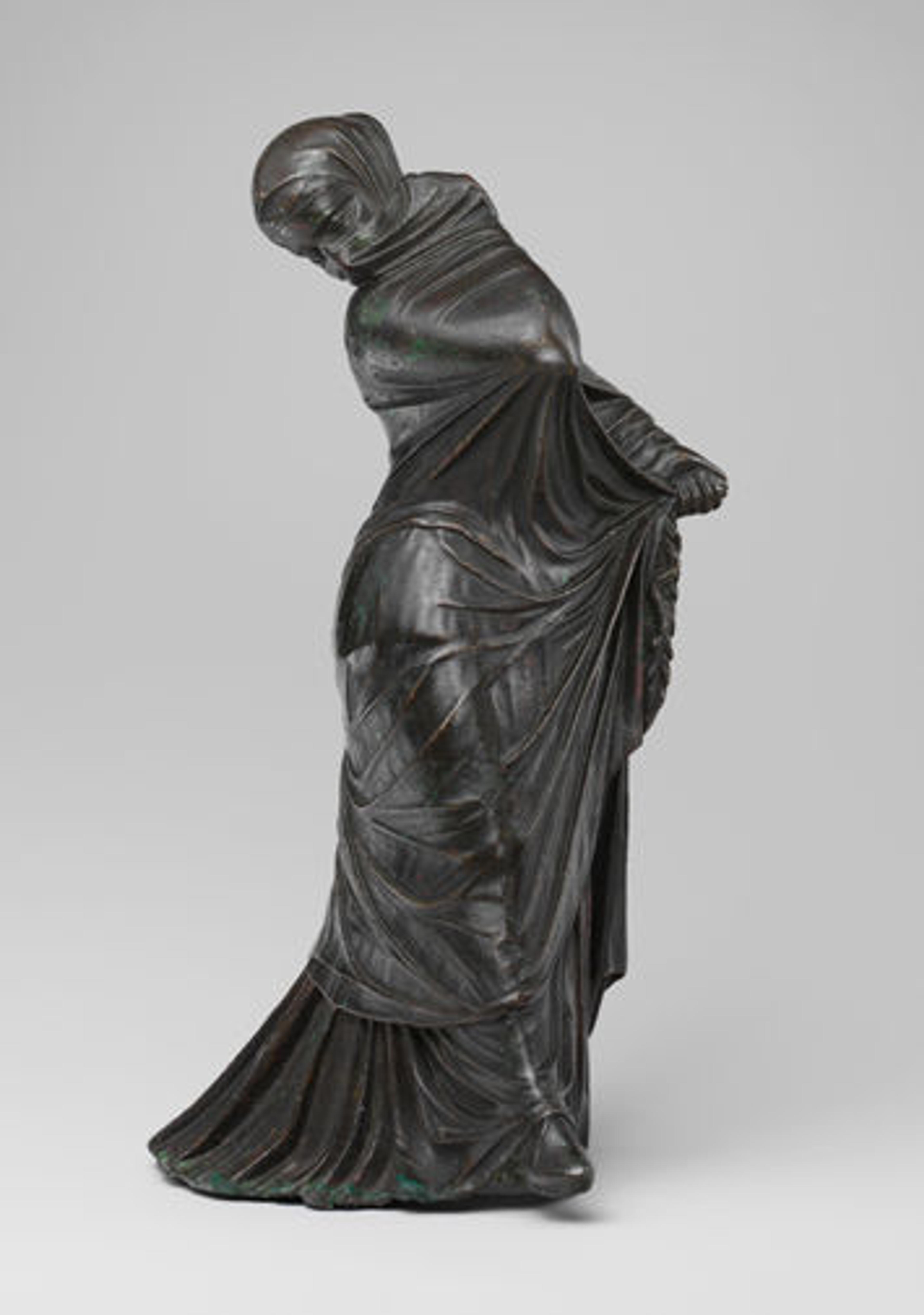
Also featured in the exhibition is The Met's own Baker Dancer (fig. 4), a bronze statuette of a veiled and masked female dancer that is a favorite of Museum visitors. It is an exquisite work of art made on an intimate scale. She performs a private dance for the viewer—a kind of dance of the seven veils—that is both alluring and surprisingly contemporary in appearance, having been rendered in a realistic style. Nonetheless, it is undoubtedly very much a product of the ethos of the Hellenistic Age, the work of a master sculptor perhaps from Alexandria, Egypt.
Right: Fig. 4. Statuette of a veiled and masked dancer, 3rd–2nd century B.C. Greek, Hellenistic. Bronze; 8 1/16 x 3 1/2 x 4 1/2 in., 65.6 oz. (20.5 x 8.9 x 11.4 cm, 4.1 lb.). The Metropolitan Museum of Art, New York, Bequest of Walter C. Baker, 1971 (1972.118.95)
Great art can be profoundly moving. This statuette inspired me to write my first novel, The Tomb of Alexander, which offers an imagined history of the Baker Dancer set in an archaeological thriller about the search for Alexander the Great's tomb. The display of the Baker Dancer in the midst of some of the finest Hellenistic luxury arts preserved today allows the visitor to understand better the milieu in which this outstanding artwork was created when, for the first time, works of art were fashioned for private display, contemplation, and enjoyment.
The final section of the exhibition features the coming of Rome as a dominant power in the Eastern Mediterranean and its development into a major center for Hellenistic art in the first century B.C. Roman intervention and conquest in the east was a long and slow process, which began as early as 229 B.C., when the first Roman army crossed the Adriatic Sea. Attalos III bequeathed Pergamon to Rome upon his death in 133 B.C., further strengthening Rome's presence in Asia Minor. Major new sculptural types, such as the sleeping hermaphrodite (fig. 5), are displayed with an emphasis on examples that appealed to Roman tastes.
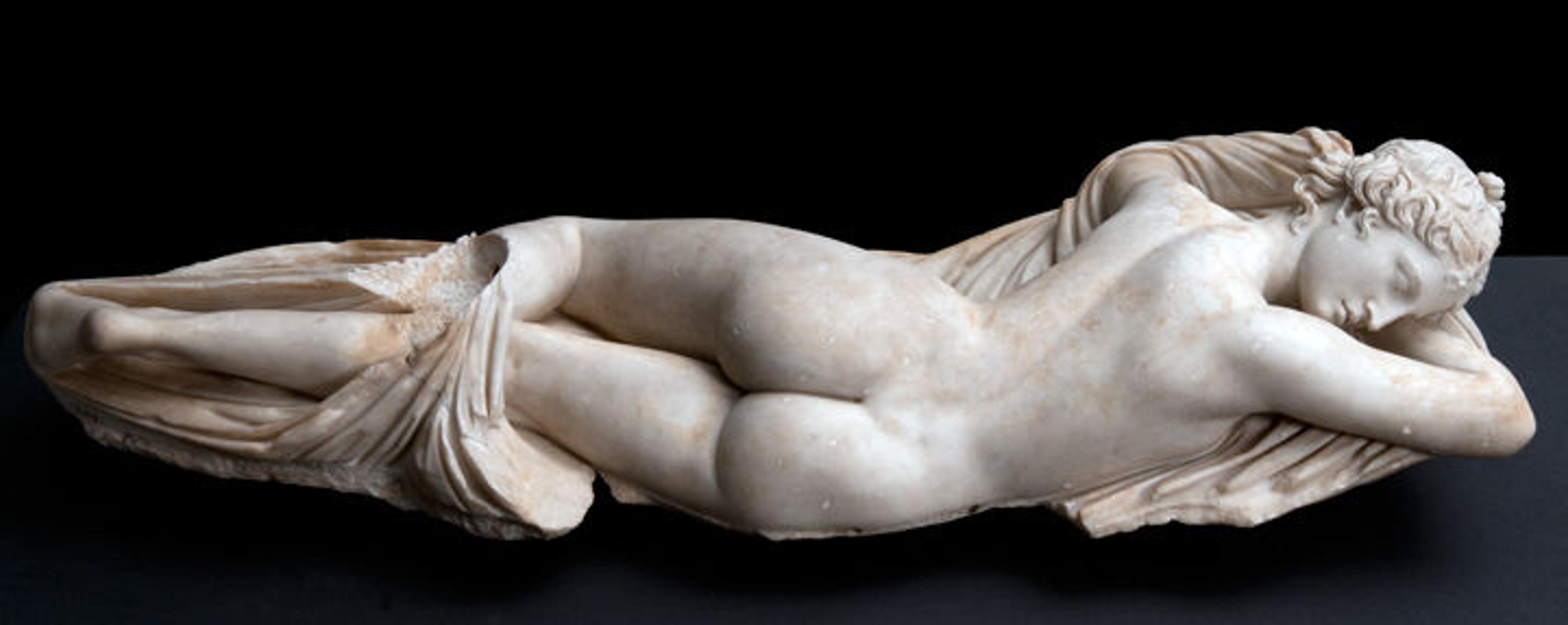
Fig. 5. Sleeping hermaphrodite, mid 2nd century A.D. Roman. Marble; 14 9/16 x 22 1/16 x 59 1/16 in., 771.6 lb. (37 x 56 x 150 cm, 350 kg), measurements include support. Museo Nazionale-Palazzo Massimo alle Terme, Rome
For the first time, a selection of the Athens National Archaeological Museum's important finds from the Antikythera shipwreck in Greek waters are on display together with finds from the Mahdia shipwreck off the coast of Tunisia. The magnificent Borghese vase (fig. 6), a type represented in the Mahdia ship's cargo, is an outstanding example of the new decorative art being created by Greek sculptors for sumptuous Roman villas. The exhibition ends with the Roman Emperor Augustus and the late Hellenistic dynasts, best exemplified by a sublime bronze bust of Juba II, who was brought to Rome as part of Caesar's triumph over Numidia, educated there, and later restored to the throne by Augustus as a client king. Although the power of the Hellenistic kingdoms came to an end in the late first century B.C., the innovations of Hellenistic artists fostered by their royal patrons would influence Roman Imperial art for centuries.
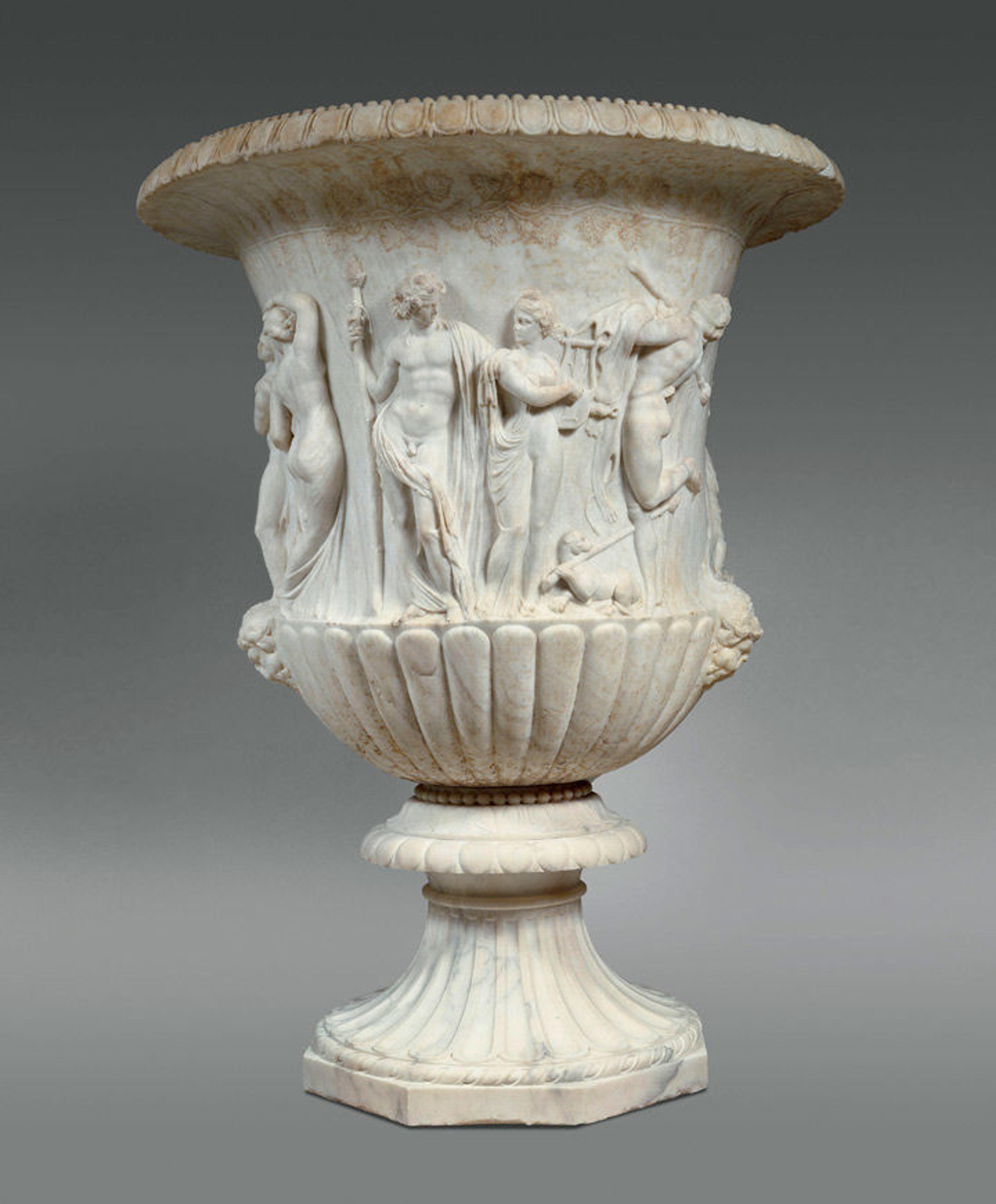
Fig. 6. Calyx-krater, so-called "Borghese Krater," 40–30 B.C. Roman. Marble; 66 15/16 x 36 in., 38797 oz. (170 x 91.4 cm, 1100 kg). Musée du Louvre, Paris, Départment des Antiquités Grecques, Étrusques et Romaines
Pergamon and the Hellenistic Kingdoms of the Ancient World is on view through July 17, 2016. Don't miss this opportunity to see an extraordinary presentation of Hellenistic art.
Séan Hemingway
Séan Hemingway is the John A. And Carole O. Moran Curator in Charge in the Department of Greek and Roman Art.